Giáo án tiếng anh lớp 7 soạn theo chương trình VNEN mới tham khảo (4)
Bạn đang xem bản rút gọn của tài liệu. Xem và tải ngay bản đầy đủ của tài liệu tại đây (136.91 KB, 6 trang )
Date of writing: 2/01/2015 English 7
Date of teaching: ___/___2015
Week 20
Period 57
UNIT 7: TRAFFIC
Lesson 1: Getting started
A. Aims and objectives .
1. Knowledge: By the end of the lesson, Ss will be able to use the lexical items related to the
topic "Traffic", use "How ?" to ask about means of transport
2. Skills: Listening and speaking skills.
3. Attitude: Sts must have good attitude while working together.
4. Competencies: Talking about past habbits with "used to"
B. Preparation
- Teaching aids: Textbook, poster, tape and radio
C. Procedures
Time Teacher's activities Students' activities
5' Warm up Matching (3 P7)
- ? Run through all the words and phrases
in 3 P7.
? Match a verb on the left with a mean of
transport on the right.
- There may be more than one correct
answers.
? Read again in chorus.
Key:
1. ride a bike 2. drive a car
3. fly a plane 4. sail on/in a boat
5. get on/ get off a bus/ a train/ a bike/ a
motorbike
10' I. Pre-listen and read
1. Vocabulary
- Teacher use different techniques to
teach vocab (situation, realia)
- Follow the seven steps of teaching
vocab.
* Checking vocab: R.O.R
2. Choose a correct answer (1a P7)
* Set the scene:
? Look at page 6
? "Monday in the play ground in
Vietnamese.
? Who are Oanh and Mai?
? What may they talk about?
? Run through the questions in 1a P7
? Guess and choose a suitable answer
before listening.
? Listen to the conversation once or twice
then check your answer.
- Teacher gets feedback
- used to (v): đã từng
- traffic jam (n): sự tắc ngẽn giao thông
- except (prep) ngoại trừ, trừ ra
- Repeat in chorus and individually
- Copy all the words
- Individual work
- They are students.
- They may talk about
Key: 1B 2. A 3. B 4. C
15' II. While - listen and read
1. Answer the questions (1b P7)
- ? Read the conversation again then
Key:
1. She played with her brother/ stayed at
answer the questions in 1b P7
? Work in pairs
home.
2. It's about 2 kilometers.
3. She usually goes to school with her dad.
4. Because sometimes there are traffic jams.
5. She goes to school by bike.
2. Colloquial expressions
? Refer back to the conversation and find
the meaning of the colloquial
expressions in 1c P7
? Practice saying them together and give
some examples
? Role-play the short conversation in 1d
P7.
? Creat your short conversations. Use the
colloquial expressions in 1c P7
? Work in pairs
1. Hey: to have someone's attention
2. Great idea: when you strongly support or
agree with something
3. Can't wait: very excited and keen to do
something.
10' III. Practice .
1. Model sentences (Remember)
- Elicit the question from students
? Practice asking and answering
questions using "How"? Recall how to
use a passive sentence.
2. Write the words (2 P7)
? Work in pairs. Write the means of
transport under the right pictures.
- Teacher monitors and gets feedback.
3. Find someone who never (4 P7)
- Teacher models
? Work in groups
- Teacher monitors and gets feedback.
- How do you come to school? = By what
means do you come to school??
- How do you go to the supermarket? = By
what means do you go to the supermarket?
1. bike/ bicycle 2. bus
3. plane 4. boat
5. ship 6. train
7. motorbike 8. car
Find someone who never
1. walks to school Nam
2. goes to school by bus
3. cycles for exercise
4. takes a train
5 sails on/in a boat
6. flies by plane
E.g:
A : Do you often walk to school?
B(Ba) : Yes, I do.
A : Do you often walk to school?
C (Nam): No. I never walk to school.
3' IV. Consolidation
? Report the results of Find someone who
never
? Sum up the main content of the lesson.
- Answer individually
E.g: Nam never walks to school
2' V. Homework
- Learn by heart vocabulary and
structures.
? Do Ex B1,2,3 P4-5 (workbook)
- Prepare: Unit 7: A closer look 1
- Listen and take note the assignments
_____________________________________
Period 58
UNIT 7: TRAFFIC
Lesson 2: A closer look 1
A. Aims and objectives .
1. Knowledge: By the end of the lesson, Ss will be able to:
- use the lexical items related to the topic "Traffic"
- know meaning of road signs
- pronounce sounds /e/ and /ei / correctly ion isolation and in context
2. Skills: Listening and speaking skills.
3. Attitude: Sts must have good attitude towards obeying the transportation rules.
4. Competencies: Talking about the meaning of the road signs
B. Preparation
- Teaching aids: Textbook, tape and radio
C. Procedures
Time Teacher's activities Students' activities
5'
I. Warm up
Brainstorming
? Give all the road signs you see every
day on the way to school
? Write as many words as possible
? Read again in chorus.
Suggestion:
- stop
- no left turn/ no right turn
- parking/ no parking
- go ahead
- no cycling
- one-way
15'
II. Vocabulary
1. Vocabulary
- Teacher use different techniques to
teach vocab (situation, realia)
- Follow the seven steps of teaching
vocab.
* Checking vocab: Labeling (2 P8)
? Label the road signs in 1 with the
words/ phrases in 2
? Read all the phrases in chorus
- Teacher explains the meaning if
necessary.
2. Look out
- Ask students to divide the road signs
in 1 into three groups: informative,
prohibitive, and warning base on their
shapes and colours.
- traffic sign/ road
sign
(n): - biển báo giao
thông
- lane (n): làn đường, đường
hẹp
- seatbelt/ safety belt (n): đai an toàn
- traffic rule (n): luật giao thông
- obey (v): tuân theo
- pavement (n): vỉa hè (cho người
đi bộ)
- Repeat in chorus and individually
- Copy all the words
Key:
1. traffic lights 2. no parking
3. no right turn 4. hospital ahead
5. parking 6. cycle lane
7. school ahead 8. no cycling
- A sign within a red triangle will warn you
of something
- Signs with red circles are mostly prohibitive
- that means you can't not do something
- Signs in blue are usually to give
information
- Teacher gets feedback and explains
? Give more examples
3. Talk about the road signs (3 87)
? Work in pairs and talk about the road
signs you see on the way to school (or
elsewhere).
- Teacher goes around and give
assistance if necessary, and check their
answers.
E.g:
A: On the way to school, I can see a "no left
turn" sign.
B: On my way to school there is a hospital,
so I can see a "hospital ahead" sign.
15'
III. Pronunciation .
1. Sounds /e/ and /ei/
? How to pronounce the sounds /e/
and /ei/?
- Teacher models and give examples.
- Ask students to observe teacher's
mouth and listen carefully
? Practice the sounds together
2. Listen and repeat (4 P9)
? Listen to the recording 2 or 3 times
? Repeat in chorus
? Read individually.
3. Identify the sounds (5 P9))
- Play the recording 2 or 3 times
? Listen and distinguish the sound /e/
and /ei/.
? Recognize all the words with the two
sounds, then underline them as assigned
? Work in groups and find words with
the two sounds
- Teacher monitors and gets feedback.
- listen and repeat
- pair work
Key:
No /e/ /ei/
1 ever break, way
2 very railway station
3 always, obey,
safety
4 left, when UK
5 They, waiting,
train
next
3'
IV. Consolidation
? Sum up the main content of the
lesson.
- Answer individually
- Remember
2'
V. Homework
- Learn by heart vocabulary and
structures.
? Do Ex A1,2 P3 (workbook)
- Prepare: Unit 7: A closer look 2
- Listen and take note the assignments
Period 59
UNIT 7: TRAFFIC
Lesson 3: A closer look 2
A. Aims and objectives .
1. Knowledge: By the end of the lesson, Ss will be able to:
- use the "it" for distance
- use "used to" to talk about past habit or state
2. Skills: Writing and speaking skills.
3. Attitude: Sts must have good attitude towards obeying the transportation rules.
4. Competencies: Asking and answering about the distance and means of transports.
B. Preparation
- Teaching aids: Textbook, tape and radio
C. Procedures
Time Teacher's activities Students' activities
5' Warm up Brainstorming
? Work in groups to write activities that
you did in the past but you don't do
them now.
Suggestion:
Activities I did in the past but not do them any
more
- ride a buffalo
- play marbles
- cry for candy
- play with a doll
- go for a walk with a dog
10' I. Presentation
1. Vocabulary
- Teacher use different techniques to
teach vocab (situation, realia)
- Follow the seven steps of teaching
vocab.
* Checking vocab: Matching
2. "It" indicating distance
? Refer back to the conversation in
getting started and find sentences with
"it" as the subject.
? Is"it" in the example the formal
subject?
? What does it indicate?
- open-air (adj): ở ngoài trời
- tricycle (n): xe ba bánh
- accident (n): tain nạn
- desk job (n): công việc bàn giấy
- pond (v): cái ao
- Repeat in chorus and individually
- Copy all the words
E.g: How far is it from your house to there?
It's about two kilometers.
-> "It": the formal subject to indicate distance
3. Used to
? Study the examples in grammar P10
? What do we use "used to" for?
- Teacher explains the rules of (+), (-),
(?)
? Give more sentences in all three form.
E.g:
There used to be many trees on this street, but
now there are only shops.
- We used "used to" to describe an action or a
state that happen regularly in the past but does
not happen at present/ no longer happen now.
- Used to is the same form for all persons.
20' II. Practice .
1. "It" indicating distance
1.1. Write sentences with it (1 P9)
? Work by yourself and write down the
sentences.
- Teacher observes and helps when and
Ex1. P9
1. It's about 700 metres from my house to
Youth Club.
2. It's about 5 km from my house to the nearest
where necessary.
- Have some students read their
sentences.
- Correct their mistakes
1.2. Ask and answer questions
about distance (2 P9)
? Work in pairs.
? Ask and answer questions about
distance in your neighborhood.
2. Used to
? Study Watch out
2.1. Complete the sentences with
"used to" or "use to"(3 P10)
? Work independently to write the
sentences in your notebook.
- Teacher monitors and gets feedback.
22. Rewrite sentences (4P10).
? Work independently to write the
sentences in your notebook.
- Teacher monitors and gets feedback.
town.
3. It's about 120 km from Ho Chi Minh City to
Vung Tau.
4. It's about 384,400 km from the Earth to the
Moon.
5. It's not very far from Ha Noi to Noi Bai
Airport.
Ex2. P9
E.g:
A: How far is it from your house to school?
B: It's about a kilometer.
Ex3. P10
1. used to ride 2. used to be
3. used to go 4. Did use to play
5. did not use to feel
Ex4. P10
1. My mum used to live in a small when she
was a girl.
2. There did not use to be (as) many vehicles on
roads.
3. We used to cycle to school two years ago.
4. Now there are more traffic accidents than
there used to be.
5. My uncle used to be a bus driver some years
ago, but now he has a desk job.
III. Production (Find someone
who)
- Give instructions
? Work in groups
? Report the result to the class
Find someone who used to
1. play marbles Phong
2. play football in the street
3. swim in the pond near
your house
4. ride a tricycle
5 ride a buffalo
E.g:
A : Did you use to play marbles?
Phong: Yes. I used to play marbles.
E.g: Phong used to play marbles.
3' IV. Consolidation
? How do we use "used to"?
- Answer individually
- Remember
2' V. Homework
-Learn by heart vocabulary and
structures.
- Do Ex B4,6 P5-6 (workbook)
- Prepare: Unit 7: Communication
- Listen and take note the assignments
Ngày 6/01/2015
BGH duyệt Tổ chuyên môn duyệt









